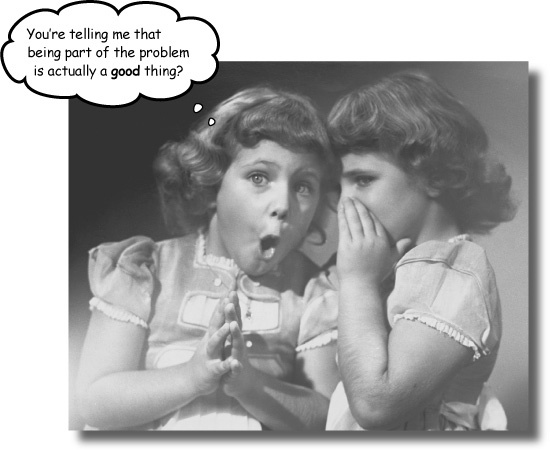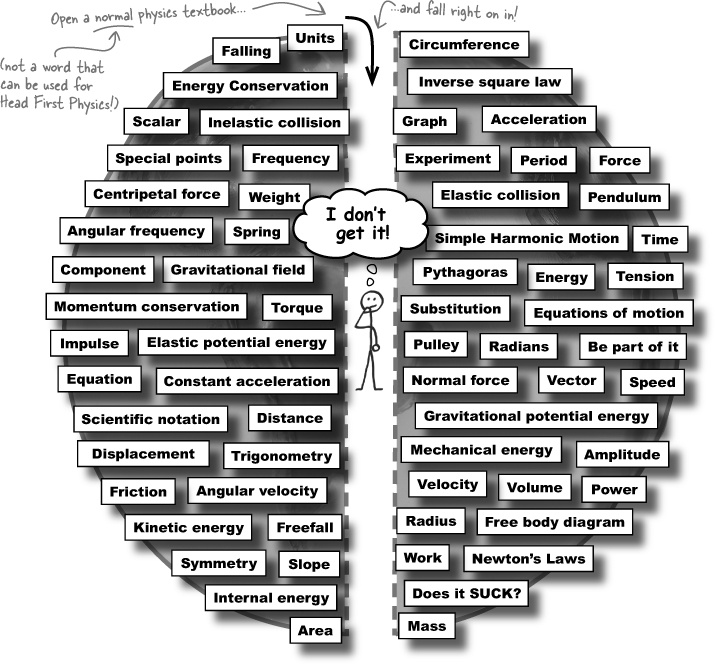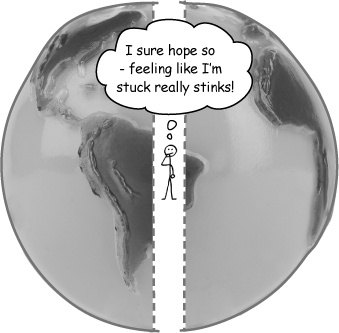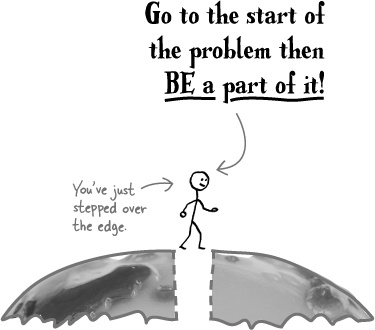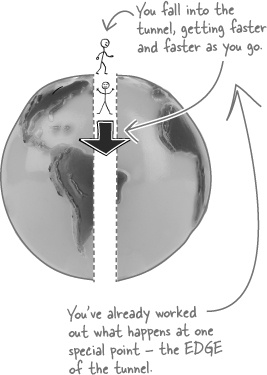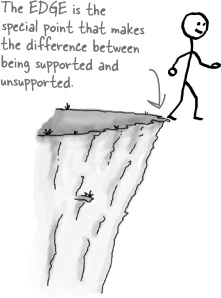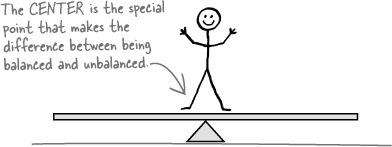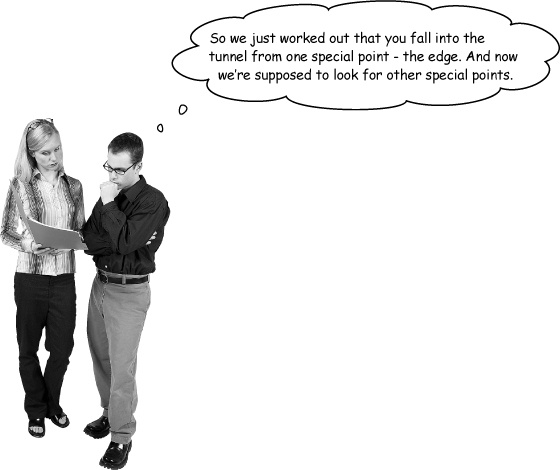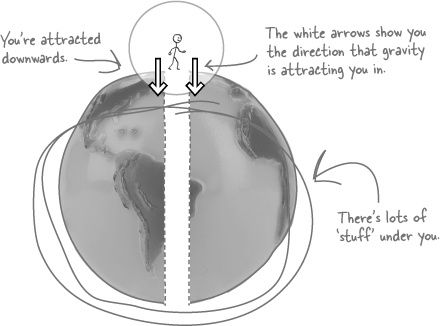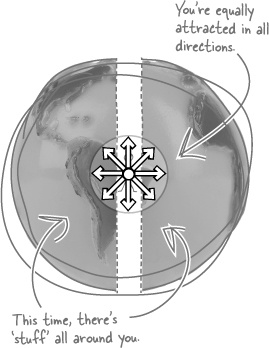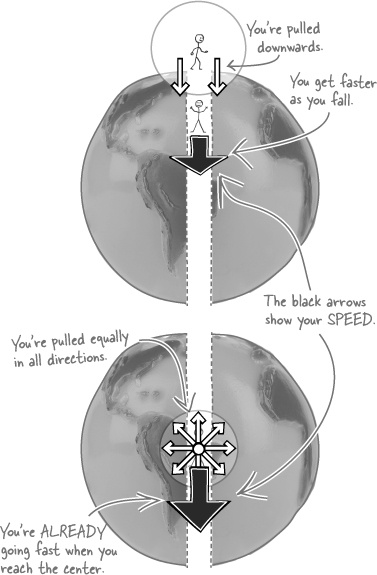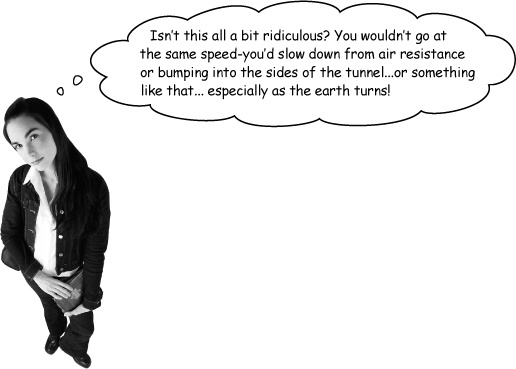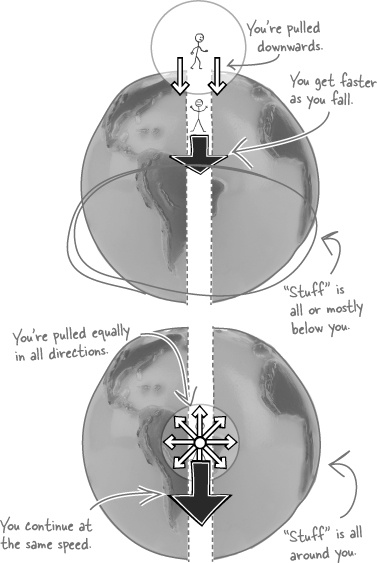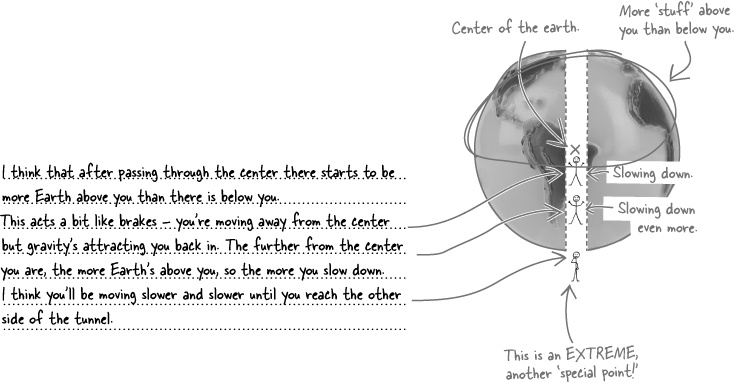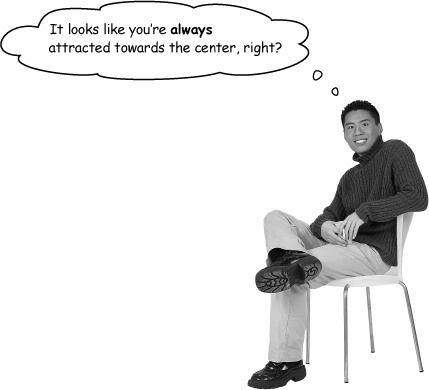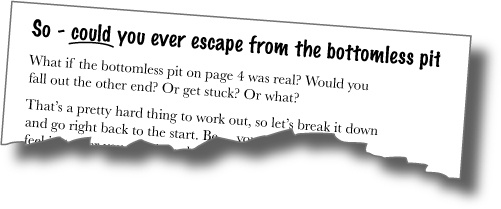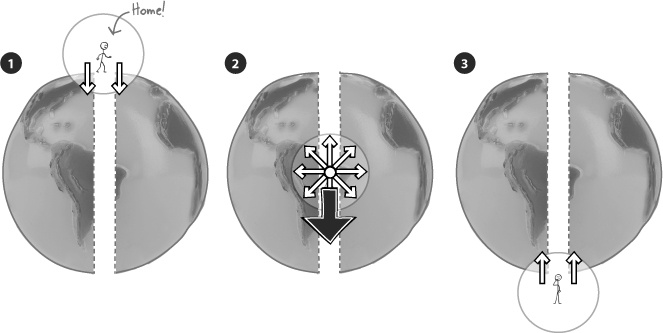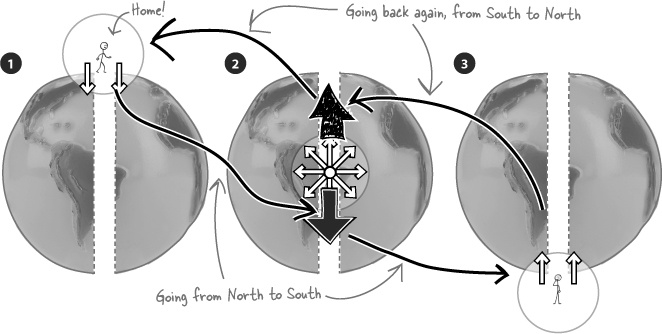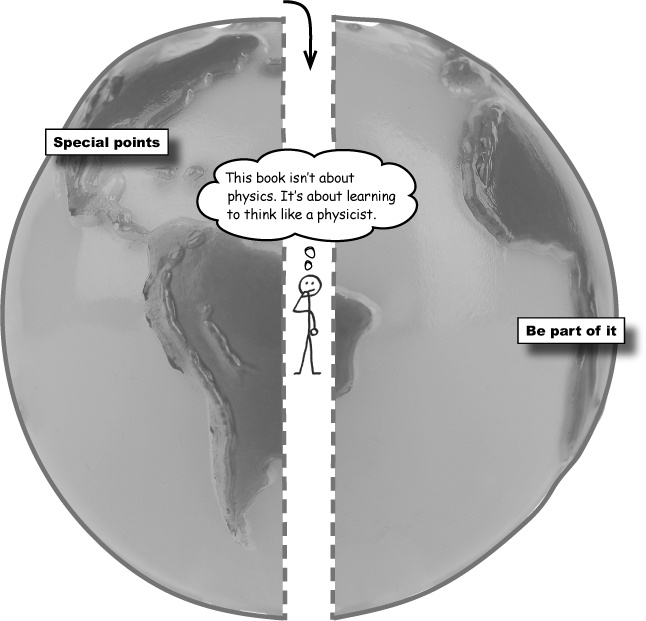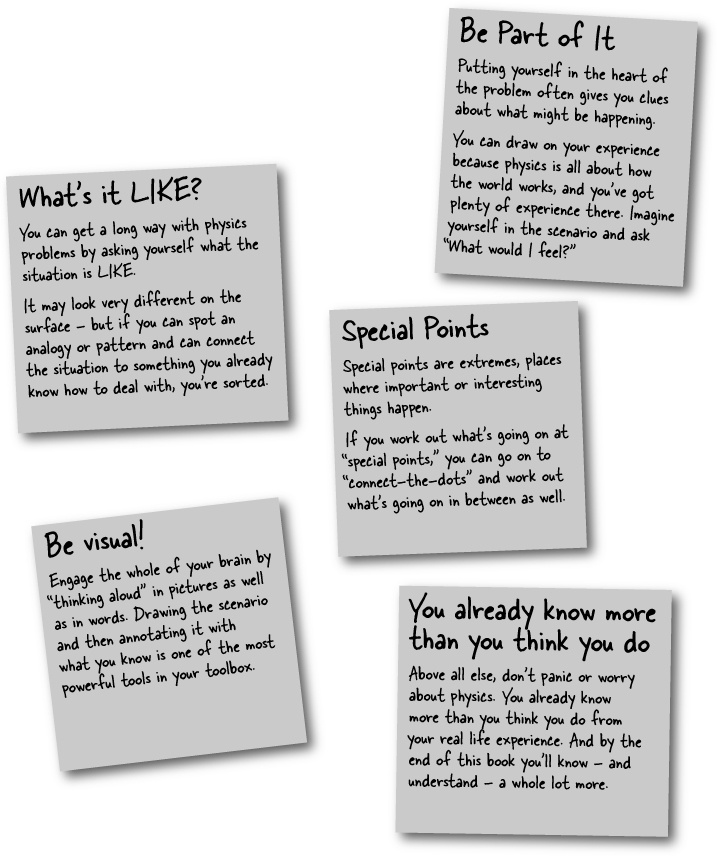Chapter 1. Think Like a Physicist: In the beginning ...
Physics is about the world around you and how everything in it works. As you go about your daily life, you’re doing physics all the time! But the thought of actually learning physics may sometimes feel like falling into a bottomless pit with no escape! Don’t worry... this chapter introduces how to think like a physicist. You’ll learn to step into problems and to use your intuition to spot patterns and ‘special points’ that make things much easier. By being part of the problem, you’re one step closer to getting to the solution...
Physics is the world around you
Physics is about the world around you and how stuff in the world actually works. How do you aim a cannon with no direct line of sight? How can a satellite orbit the earth without falling back down? Will you win a prize shooting ducks at the fairground? Will the Dingo catch the Emu...
All of this should be really interesting... except that opening a normal physics textbook can make you feel rather like you’ve just fallen into a bottomless pit....
But there’s hope, because...
You already know more than you think you do!
You can get a feel for what’s going on by being a part of it. | |
You can use your intuition to spot special points. | |
You can use your life experience to spot what things are like. |
This book is all about learning to think like a physicist.
You can get a feel for what’s happening by being a part of it
The best way to get started with any kind of physics is to imagine that you’re there, in the middle of it. Maybe you’re a block, or a car, or a racing driver. Then ask yourself, “What would I feel?”
Which direction am I moving in?
Am I speeding up or slowing down?
Is there anything pushing or pulling me?
(and so on...)
Be a part of it!
So - could you ever escape from the bottomless pit?
Suppose you really are falling into a bottomless pit that runs from one side of the world to the other. What do you think would happen (assuming that the earth isn’t hot and molten inside)?
Not sure where to start? That’s okay ... break it down and go right back to the beginning. Be a part of the problem! Ask yourself, “What would I feel just after I step into the tunnel?”
Ask yourself, “What would I FEEL if I was part of the scenario?”
Use your intuition to look for ‘special points’
You’ve just started off the bottomless pit problem by being a part of it. You started at the start, imagined you’d just stepped over the edge, and asked yourself “What would I feel?” And you know that you’ll fall into the tunnel, getting faster as you go.
But what happens next?
The key is to use your intuition to look for ‘special points’ – places where important or interesting things happen.
For example, the edge of a cliff is a special point because that’s where you change from being supported by the ground to being unsupported. And the center of a seesaw is a ‘special point’ because it’s the only place on the seesaw that one person can stand without either side going up or down.
Spotting special points then asking “What would I feel if I was there?” helps you to understand what’s going on.
You already did that for one special point - at the edge of the tunnel. Now it’s time to look out for more special points in this problem, so you can think about what’s going on there.
Once you know what’s happening at each special point you can play connect the dots and work out what’s happening in between too.
In physics, the ‘special points’ where things happen are usually at the EDGES and in the CENTER.
Brain Power
The edge of the tunnel is a special point. Can you spot any other special points in this problem?
Jill: I have a hunch that the center of the earth must be important - it just looks like it must be!
Frank: Yeah. Even though we’re assuming the center of the earth isn’t hot (because we’re dealing with an Earth which has lots of physics words written on it), the center still looks really important!
Jill: But what’s gonna happen there?
Frank: I’m not sure. I guess that either you stop, or you keep on falling. But that’s not narrowing it down all that much!
Jill: Maybe we can use what we already figured out? Didn’t we say that when you’re at the surface and step over the edge of the tunnel, you fall down into the tunnel because of gravity?
Frank: Yeah, that’s right. I guess that the earth attracts you because it’s so big. Gravity is the stuff the earth’s made of and the stuff you’re made of attracting each other, right?
Jill: And when you’re at the surface - at the edge of the tunnel - the whole of the earth is under you. So gravity attracts you downwards.
Frank: Yeah, that makes sense. So what’s going on in the center? The whole Earth isn’t under you any more - it’s kinda all around you. There’s the same amount of Earth around you in all directions!
Jill: Then you must get pulled in all directions at once. Ouch! Sounds like you’d get torn apart or something!
Frank: Hmm. The Earth’s gravity isn’t strong enough to pull my atoms apart when I’m standing on the surface. I have a feeling it’ll be more like standing in the exact center of a seesaw.
Jill: You mean, kinda like a balance point? I guess if you were at either end of the seesaw - or at either end of the tunnel - you’d move. But if you’re in the center of the seesaw - or the center of the earth, you’re balanced.
Frank: Yeah. With the seesaw, it’s like you have one foot ‘pulling’ you an equal amount each way, so you stay balanced. And in the center of the earth, you have half the earth on one side and half the earth on the other side. That’s balanced too.
Jill: So you must stop when you reach the center of the earth if you balance there. We solved the problem - you never get out!
Frank: Hmm... but didn’t we say before that you’re already moving very fast by the time you reach the center?
Once you’ve found a special point, ask yourself: “What would I FEEL there?” and “What is being there LIKE?”
The center of the earth is a special point
As Frank and Jill have worked out, the center of the earth is a special point where important or interesting things might happen. Maybe your eye was drawn to the center because of the symmetry, as there’s the same amount of Earth around you in all directions.
So - be a part of it! Imagine yourself at the center of the earth. What would I feel there? What is being there like?
At the first special point—the edge of the tunnel—you’re pulled downwards into the tunnel by gravity. This is because of the attraction between the “stuff ” the earth’s made of and the “stuff ” you’re made of.
(Stuff isn’t a particularly technical term - we’re basically using it to mean all of your atoms.)
At the second special point, in the center of the earth, all of your atoms are pulled equally in all directions. You aren’t attracted in any direction more strongly that you are in any other direction.
Being attracted in all directions at once may not sound like fun - but you’re made of stronger stuff. The Earth’s gravity isn’t strong enough to pull your atoms apart. This means that all of the attractions balance each other out.
At the center, you’re equally attracted in all directions - so all the gravitational attractions balance out.
Ask yourself “What am I ALREADY doing as I reach the special point?”
But Frank and Jill nearly made a big mistake when they were thinking about out what it would feel like in the center of the earth. At first, they thought that if all the gravitational attractions balance out, then you’ll be stationary in the center of the earth, like you are when you balance yourself on the center of a seesaw.
But is that really true? You’re already going very fast when you reach the center of the earth. You’ve fallen a very long way to get there, moving faster and faster all the time. If all the attractions balance out, what is there to slow you down?
What is it like to be already going fast when there’s nothing pulling or pushing you?
When you put yourself in a problem, try to imagine what you’re ALREADY doing when you reach the special point before going on to think about what happens next.
That’s right - we’ve made some assumptions to turn the problem into a simpler version
We already made an assumption back on page 4 that (for this problem) the earth is solid and isn’t hot in the middle, as getting fried isn’t helpful.
And quite right - we’re also assuming that air resistance doesn’t slow you down and that the pit goes between the North and South poles, so you don’t hit the sides as the earth turns.
In physics, the way of solving a complex problem is often to make approximations or assumptions to turn it into a simpler problem. That’s OK, as you can ask yourself later on what the difference would be if you hadn’t made the assumption. But only once you’ve got to come to grips with the simpler version.
Note
Sometimes, including all the hard stuff right from the start makes the problem impossible to solve.
In physics, you sometimes make approximations or assumptions to turn a complex problem into a simpler version.
Understanding the simpler version helps you with the complex version.
Where you’re at - and what happens next?
You’ve learned to step into the problem, so you can be a part of it and ask “What would I feel” and “What’s it like.” This is a good way to start off and helps you see what the important things in the problem are. Here, you realized that gravity is important, and that you fall towards the center of the earth, getting faster and faster as you go.
You’ve also used your intuition to spot ‘special points.’ You’ve spotted that the center of the earth is a place where the gravitational attraction between the stuff you’re made of and the stuff the earth’s made of is the same in all directions.
And you worked out that this means you just keep on going at the same speed you were already going at as you pass through the center because there’s nothing to slow you down! So you’re going quickly, but you aren’t getting faster and faster anymore.
But now you’re through the center, what happens next? What would you feel? What’s it like? You already know that gravity is important and that its influence depends on where you and the earth are compared to each other. So - what happens next?
Note
Hint: Think about where the majority of the earth’s “stuff” is when you’re at various points in the tunnel.
You’re always attracted towards the center unless you’re already in the center.
Right. When you’re on the surface at the start, there’s a lot more Earth under you than there is on top of you, and you’re attracted towards the center. This makes you speed up.
When you’re in the center, the attractions all cancel each other out, and you keep going at the same speed.
As you move through the center towards the other side, there’s more and more Earth above you than there is below you. So you start being attracted back towards the center, which slows you down.
Now put it all together
Back on page 4, you wondered if you could ever escape from the bottomless pit. Being able to step out at the other side of the earth doesn’t really count as escaping, as you’d be a very long way from where you started!
So - are you going to be able to get back home again, or are you doomed to hang out at the other end of the bottomless pit forever?
Not only can you escape, you end up on top of the world!
You can get a feel for what’s going on by being a part of it. | |
You can use your intuition to spot special points. | |
You can use your life experience to spot what things are like. |
Your Physics Toolbox
You’ve got Chapter 1 under your belt, and you’ve added some problem-solving concepts to your toolbox.
Get Head First Physics now with the O’Reilly learning platform.
O’Reilly members experience books, live events, courses curated by job role, and more from O’Reilly and nearly 200 top publishers.
